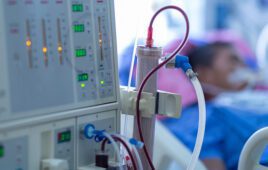Sustainable design in medical electrical equipment can fulfill regulatory requirements, decrease environmental impact and satisfy demands from patients and healthcare providers alike.
Michael Lynch, Intertek

(Image by Angela Benito on Unsplash)
Environmentally conscious product design has taken hold across many industries, including medical devices. Manufacturers who want to design and produce sustainable medical devices and medical electrical equipment must meet certain standards to claim environmentally conscious design.
A standard published by the International Electrotechnical Commission, IEC 60601-1-9 provides a formal way to verify sustainability claims, including guidance for the design phase that can be leveraged to develop sustainable medical devices.
Standard overview
Published in 2007 and amended in 2013, IEC 60601-1-9 is a collateral standard to the widely accepted international standard for the basic safety and essential performance of medical electrical equipment, IEC 60601-1. It seeks to improve environmental impact at all stages of a medical device’s life cycle: initial concept, design, manufacturing, sales, logistics, installation, use and end-of-life management.
The criteria in IEC 60601-1-9 must be integrated into all stages of the medical electrical equipment lifecycle, from the specification stage to end-of-life management. However, the standard does not provide a simple list of eco-friendly design specifications. Manufacturers instead must demonstrate how they used eco-design principles in the product’s design and development. Compliance assessment checks specified in the standard are based on verifying that procedures are in place and there is documented evidence that those procedures are followed.
Requirements
IEC 60601-1-9 is related to several other standards, including ISO 14971, ISO 14001 and ISO 14062. Through these links, the following requirements apply to the IEC standard for sustainability:
• In compliance with ISO 14971, environmental protection must be included as one element of the overall risk management process. ISO 14971 deals with influences of medical devices on the environment. It considers factors such as emissions of toxic materials, biological threats and chemical hazards. Assessing these factors at each stage of development provides valuable input for the risk management process and for the overall sustainability considerations of the device.
• ISO 14001 Edition 2015, which includes guidance on implementing processes for managing environmental concerns throughout a product’s lifespan, integrates life-cycle thinking into IEC 60601-1-9.
• An emphasis is placed on ISO 14062 to integrate environmental management considerations into product design and development.
IEC 60601-1-9 also has its own requirements that are not found in other standards. These include:
• Manufacturers must establish, implement and maintain a process to identify and document environmental aspects across all life-cycle stages of a given product. This includes determining aspects that may have significant environmental impacts across the stages and identifying suppliers who contribute to significant environmental aspects. From these suppliers, manufacturers must obtain information necessary to identify and assess these same aspects.
• Manufacturers must also establish and document a process to minimize adverse environmental impacts across all life-cycle stages. Emerging or alternative technologies must be considered and significant aspects of a representative prototype of the final design must be assessed and documented, as should any deviations from the target.
• All relevant information on the type and mass of packaging materials must be made available.
• Manufacturers must provide instructions in accompanying documents for minimizing the environmental impact of a product during normal use. Additionally, those accountable for the use and maintenance of the product must receive information for proper disposal at end of life.
Compliance
To illustrate a product’s compliance with the standard, manufacturers will need to submit several types of documentation, including:
• Design documents and process description relevant to the identification of environmental aspects and information from the supply chain, as well as those that are relevant for the reduction of adverse environmental impacts.
• Information on packaging, as well as accompanying documents, and sections relevant for minimizing environmental impact during normal use.
• Information related to end-of-life management.
Assessments of this documentation can be done independently from the evaluations of the other requirements of the IEC 60601 series. A manufacturer may also use risk analysis to help determine environmental improvement targets, but this is not required. A risk analysis will produce the necessary documentation and build the environmental considerations into the design and production process, providing valuable resources and insights.
Manufacturers must balance the acceptability of medical electrical equipment’s environmental impacts against other factors: intended function, performance, safety, cost, marketability, quality and legal and regulatory requirements. That balance can differ depending on the intended use of a device. A solution appropriate for life-saving or life-supporting equipment might not be appropriate for a device intended to treat a minor ailment. This means a manufacturer must also be prepared to justify that medical benefit outweighs the associated adverse environmental impacts.
Regardless of the reasons for verifying a device’s environmental impact, using IEC 60601-1-9 as a guide can support sustainability claims and help bring greener medical devices to the market.
Michael Lynch is a managing consultant for Intertek with more than 30 years’ experience developing a range of medical devices. He has managed the product development process from concept through full-scale manufacture, is co-inventor on five U.S. patents and is recognized within the industry for his technical competence and ability to identify issues during design reviews.
The opinions expressed in this blog post are the author’s only and do not necessarily reflect those of Medical Design and Outsourcing or its employees.




